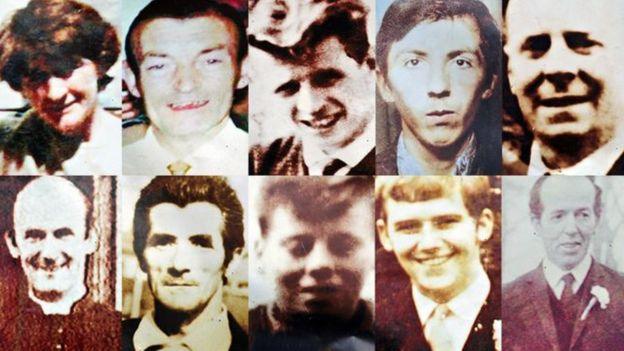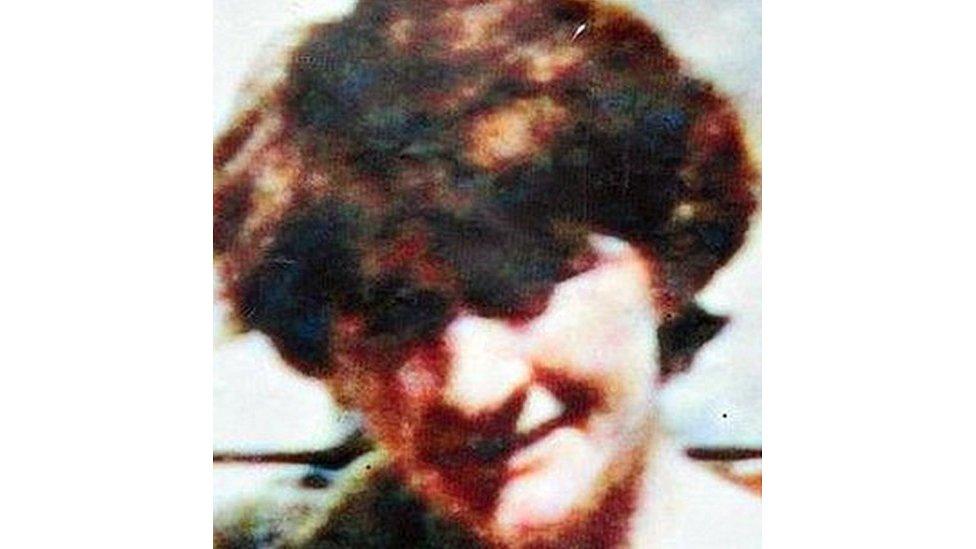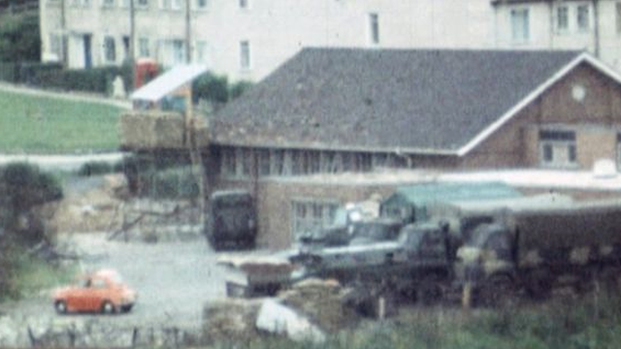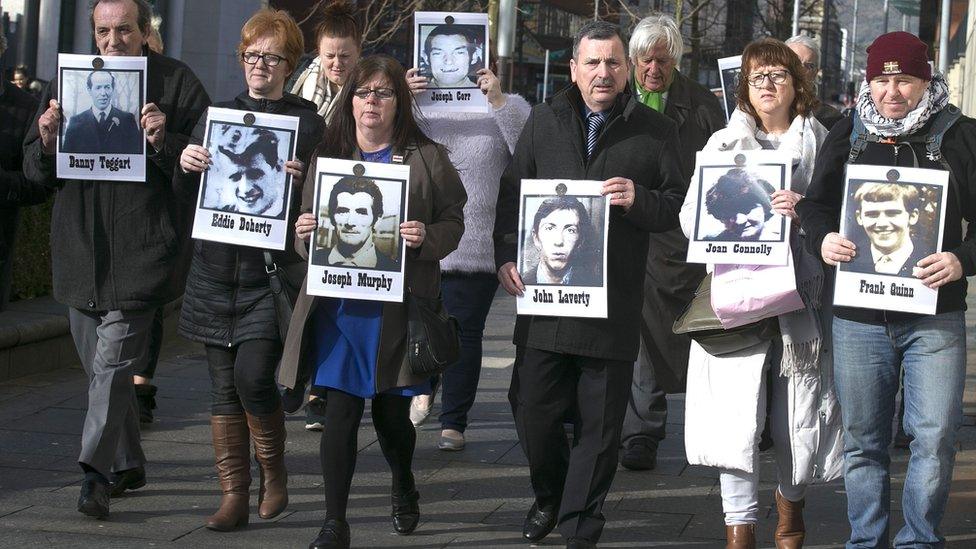Ballymurphy inquest: Soldiers lifted body 'like sack of potatoes'
- Published

Ten people were killed in the shootings
A witness has told the Ballymurphy Inquest that she saw soldiers lifting the body of a woman "like a sack of potatoes".
The witness, Agnes Keenan, was in her 30s in 1971, and is now 82.
The inquest is examining the deaths of 10 people in the Ballymurphy area of west Belfast in August 1971.
Ms Keenan lived in a house on the Springfield Road right beside the Manse area, where four people were fatally shot.
Among them was Joan Connolly, the only woman to die in the shootings, and Joseph Murphy, Noel Phillips and Daniel Teggart.
Mrs Keenan told the court that during a prolonged period of gunfire she sheltered in her home with her sister Margaret, sister-in-law Phyllis, and Phyllis's three children.
She described how, in the middle of the night when it was very dark, she heard a rumble of a vehicle beside the house.
She said in the darkness she crawled on her stomach across the floor to a window overlooking the waste ground at the Manse area.
The inquest has already heard that this was a window where, some hours earlier, her sister, Margaret, had already jumped back out of sight because gunfire was raking the wall around it.

Joan Connolly, a 44-year-old mother of eight, was the only woman shot in the Ballymurphy killings
Mrs Keenan felt she could easily have been shot herself.
"I was stupid," Mrs Keenan had told an interviewer, the court heard.
"I could have been a marksman, the soldiers, you couldn't blame them."
'They threw her on'
She described a picture of lying there, seeing uniformed figures through the window, legs, the lights of torches, and the back of an Army vehicle.
Inside were bodies, she said, "arms and legs", and she could see the head of a man.
Then, she said, she saw two soldiers lift Joan Connolly's body to the vehicle.
"They threw her on" Mrs Keenan had said in a statement in 1999, read out in court.
"That will stay with me until I die, you know. You always say that the dead deserve respect. That will stay with me until the day I die."

Manse field area opposite the Henry Taggart Hall
Mrs Keenan explained that she had seen Joan Connolly earlier in the day with a crowd of people at the gate outside her house.
She said that Mrs Connolly was "agitated" and was carrying a short stick, something she felt no soldier could have mistaken for a weapon.
She said the crowd scattered when soldiers emerged from the Henry Taggart base and stood in formation with their weapons raised.
Bodies and casualties
Earlier on Thursday, a former paratrooper told the inquest that he saw dead bodies and wounded civilians being brought into an Army base shortly after an exchange of prolonged gunfire.
Soldier M1374 said he saw the bloodied body of a woman and at least two other casualties.
The former Private Rifleman was giving evidence screened from the public.
He was in B Company, 2 Para and billeted in the Vere Foster school but was inside the Henry Taggart Hall beside it when shooting broke out, he said.
High velocity bullets were flying over them towards the school, he thought.

Soldiers from the Parachute Regiment were based at Henry Taggart Army base
He described the supersonic crack of the bullet flying overhead, and the thump of the sound of the rifle firing, a moment later.
M1374 described piling benches against a wall so he and his colleagues could see through high windows in the hall.
He explained that he could only manage to see the roofs of houses opposite, and was immediately told to get down.
He said neither he nor any of his colleagues fired their weapons, and he then moved outside behind some sandbags where soldiers with rifles were covering the waste ground opposite.
M1374 said he covered some nearby flats in the Moyard area and was unable to see the waste ground.
He told the court that none of the soldiers fired their weapons at that time.
He said that later, when it was dark, a lieutenant took some soldiers in an armoured vehicle to go to the waste ground, and returned some time later.
The body of a woman
M1374 described seeing the officer carry the body of a woman on his back into the base.
He recalled that she was dead, covered in blood, and that when he saw her again later he noticed she had been shot in the face.
A barrister for the family of Joan Connolly asked about the way the woman's body was brought in.
"She was brought in as one would carry a sack of coal or a sack of potatoes?" he asked.
"Like a piggy back," the former soldier replied.
M1374 said he saw a man in his 30s or 40s brought in on a stretcher and taken to a medical room.
He described being told to guard another casualty outside the room.
He initially thought the man had not been badly hurt because he was groaning and there did not seem to be any blood.
Making eye contact with Lieutenant
However, when he later helped lift that man's stretcher into the medical room he noticed a great deal of blood had soaked into it.
He remembers seeing a body covered with a sheet inside the medical room.
He said that he also saw the woman's head injuries and walked out, making eye contact with the Lieutenant who had brought the woman in.
A barrister for the Connolly family asked why M1374 had looked at the officer so deliberately.

Families of those killed in the Ballymurphy massacre
He asked: "Was it because you thought: 'Oh my God, we've shot a woman'?"
"Was it because you thought: 'Oh my God, there are going to be repercussions'?"
"No," replied M1374.
"Were you of the view that the Paras were gong to have to get their story straight?" the barrister asked.
"Statements would have had to be made," replied M1374.
He added: "They would have to tell the truth."
Later M1374 said he moved back to Vere Foster school, where he saw the muzzle flashes of rifle fire from some houses in the protestant Springmartin area.
The next day he was tasked with clearing up outside the Henry Taggart Hall after the previous day's rioting, and said he could see damage to the sangars at the base.
He said he took the damage to be from gunfire and stones thrown during rioting.